Empower and motivate students to read more, write more, and think more creatively
while fulfilling your curriculum objectives
It’s painful seeing students who have little interest in reading, writing, or creative thinking, because you know how important those skills are for their lives.
You don’t want them motivated by fear of bad grades, by threats from their parents, or even by rewards.
You want them motivated from within.
Teaching 4th graders how Hidden Pictures work
When they’re motivated from within . . .
• They raise their hands with questions because they want to understand the subject better.
• They check books out of the library on their own. They want to read to learn more about the subject or to explore the world of the author’s imagination.
• You see the gears turn in their heads as they think about what the author has written.
• You see those same gears turn as they think about what they want to write, stories with well-developed characters, setting, plot, and dialogue.
• They’re excited about learning. And excited about where learning can take them.
There’s a proven way to motivate your students to read more, write more, and think more creatively
When an author or illustrator visits your school, your students will meet someone who loves reading and writing enough to write or illustrate books and get published.
A 2019 study from the National Literacy Trust shows that students who had an author or illustrator visit that year
• Were twice as likely to read above the expected level.
• Were more likely to enjoy reading and writing.
• Were more likely to be highly confident in their reading and writing.
Jonathan Douglas, Director of the National Literacy Trust said,
“We cannot overstate how important author visits are for sparking a love of reading and writing in children that will ignite their imaginations, enhance their wellbeing and transform their life chances.”
When I visit schools as a guest Author-Illustrator
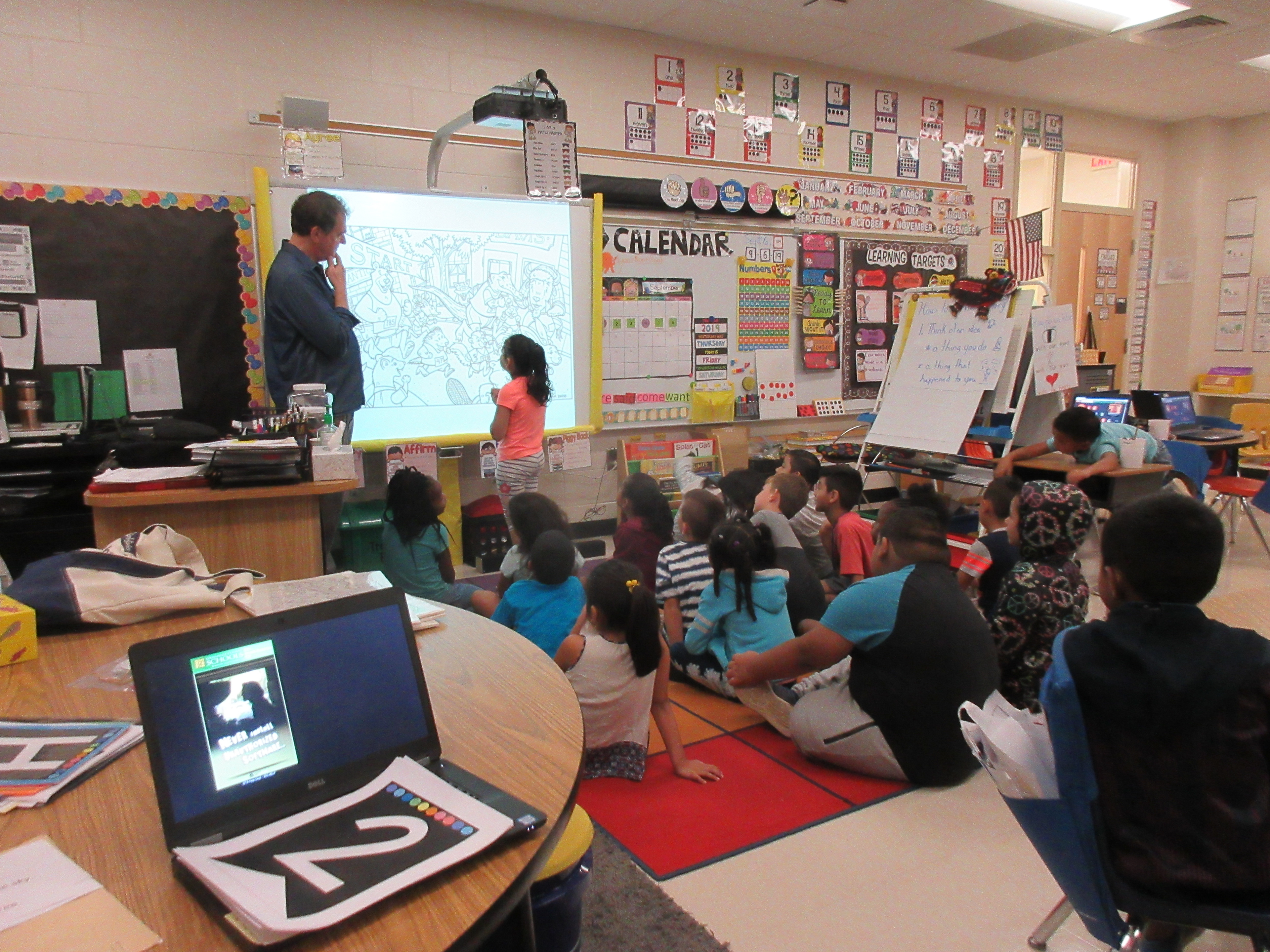
Kids love doing Hidden Pictures and storytelling interactively.
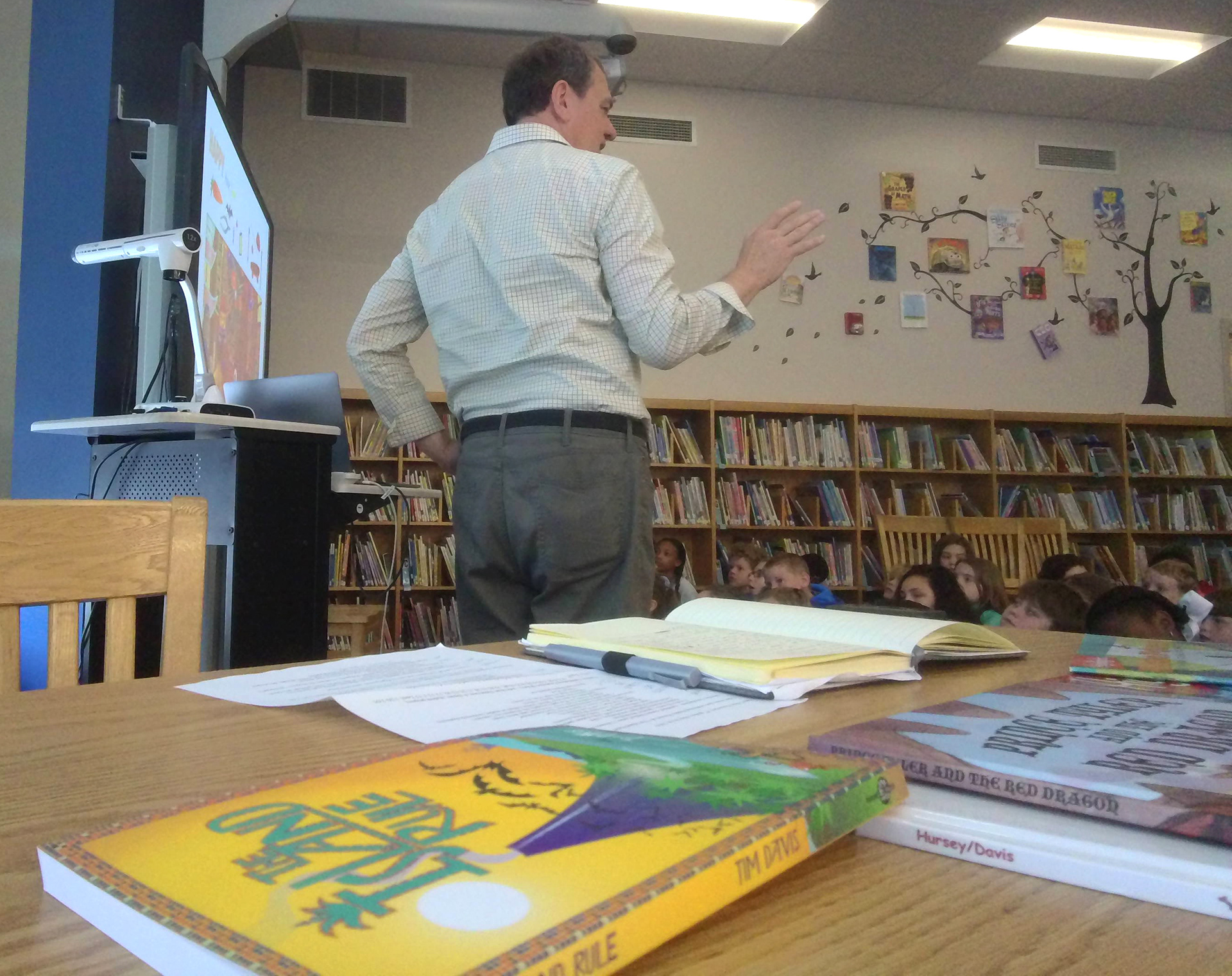
Storytelling with Tim's chapter book adventures.
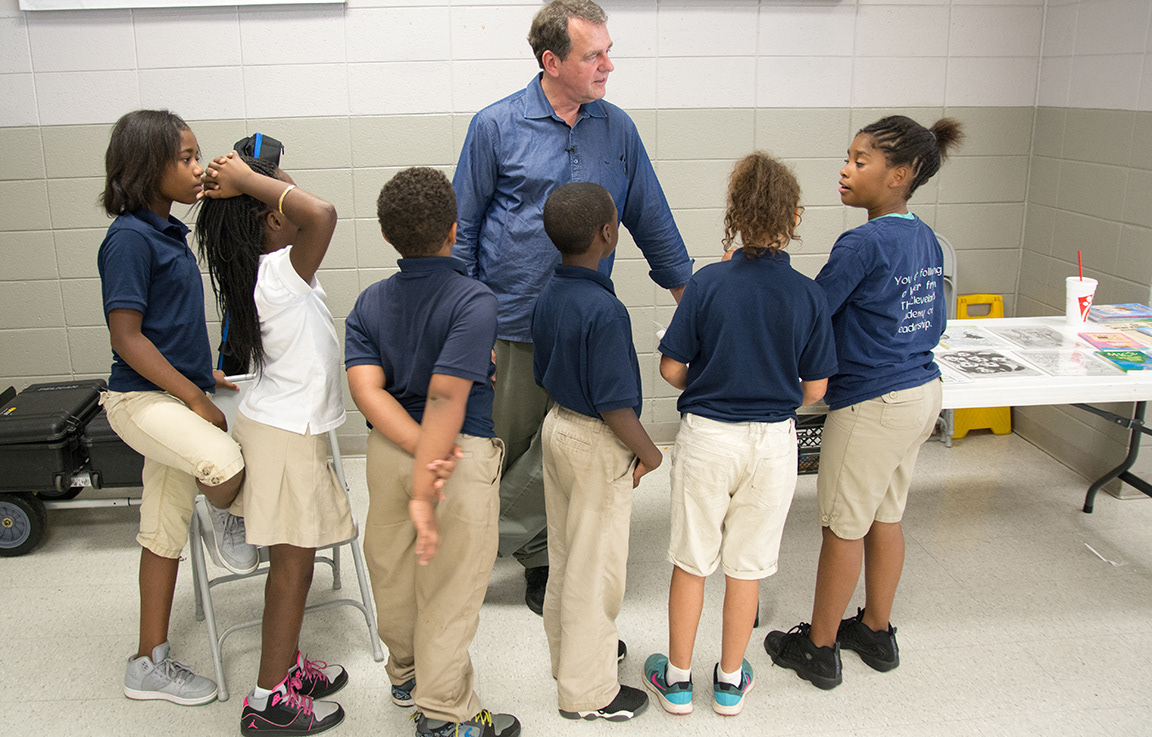
Making personal connections is geared to inspire creativity in students.
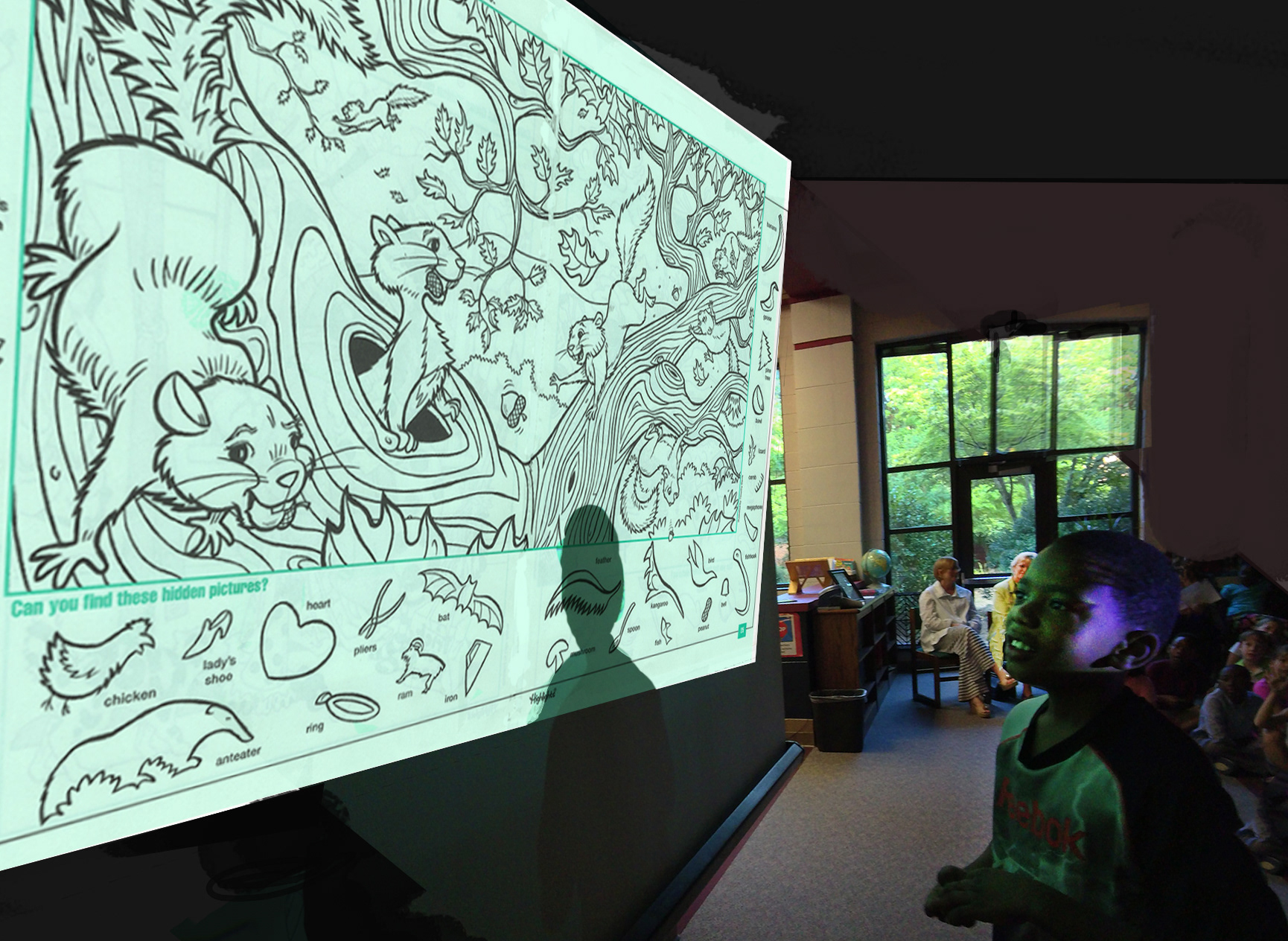
The challenge of finding Hidden Objects!
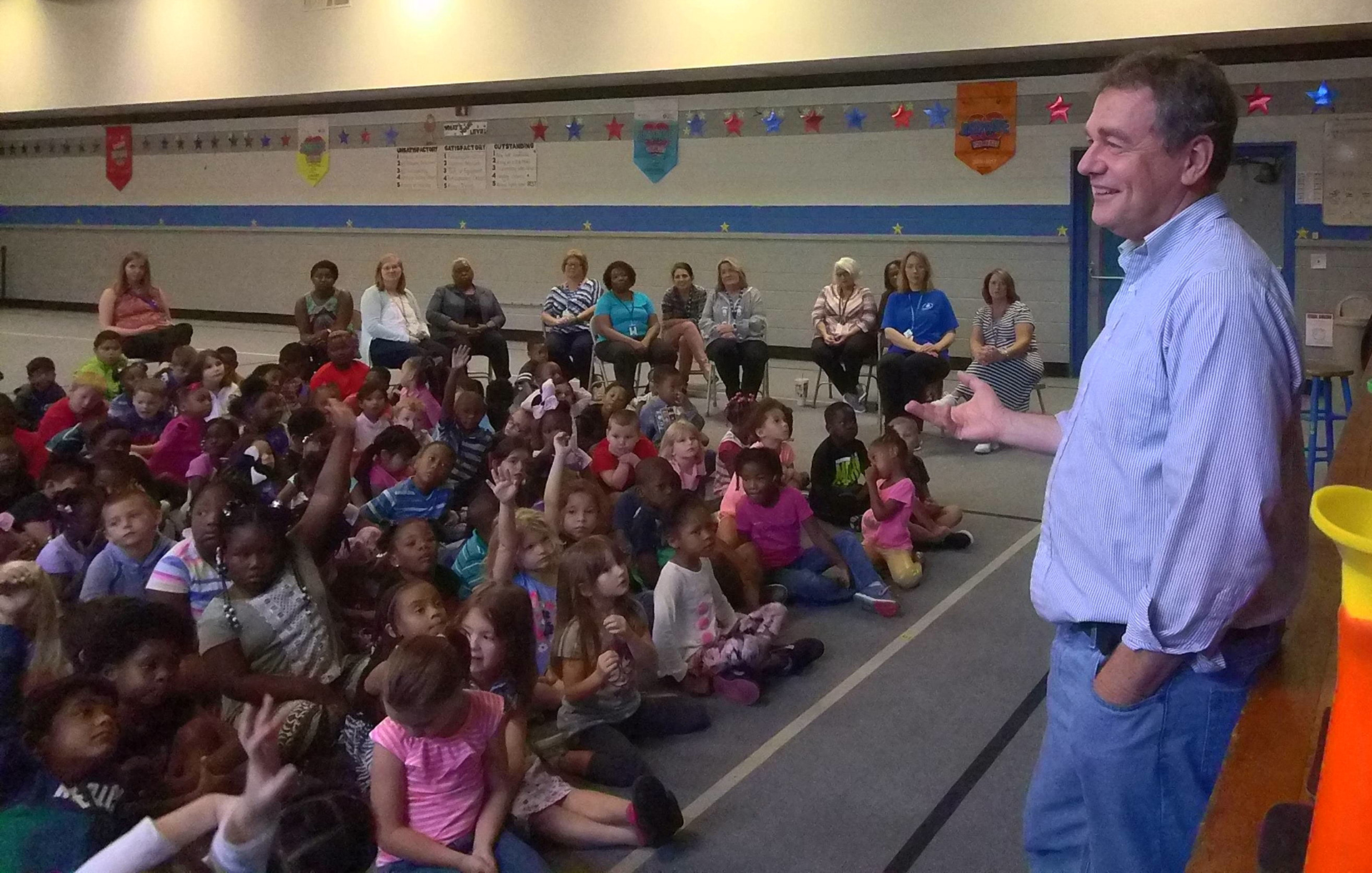
Presentations are available for assemblies or classrooms.
Your students will get a presentation they’ll love . . .
For 25 years I’ve been visiting children in their classrooms to inspire their creative talents as budding storytellers and illustrators.
When I was their age, looking at Highlights Hidden Pictures® in the doctor’s office, I never dreamed I’d one day hold the record for drawing the most Hidden Pictures® ever.
Since becoming a full-time freelance illustrator, I’ve worked for clients such as Fisher-Price (coloring books), Scholastic (Clifford the Big Red Dog), and Highlights magazine.
My Highlights cover here was featured on The Daily Show, The Today Show, and the Onion. In fact, I’ve illustrated more Hidden Pictures for Highlights magazine than any other illustrator in the world.
And they’ll get a presentation they’ll learn from
Through teaching them about my Hidden Picture illustrations for Highlights magazine, and through teaching from my own children’s books, they’ll connect back and forth between pictures and words.
In sessions of around 45 minutes, younger students will practice observation, analysis, and creative problem solving.
They’ll compare and contrast, express creativity in their own work, and use their imaginations as they develop their own Hidden Picture.
Older students will observe and analyze creative work in illustration and writing. They’ll analyze the development of setting, characters, plot, and dialogue in a story.
And they’ll express creativity and use their imaginations as they write and illustrate their own story and their own Hidden Picture.
These activities naturally help students stretch their powers for reading, writing, and creative thinking.
Teaching kids about creative writing interactively, back and forth from pictures to words, and words to pictures, naturally stretches their powers for storytelling.
Yvonne Kelly, first grade teacher, describes how it worked in her class:
I highly recommend Tim Davis as a resident artist . . . He and his team were able to role play chapters from his book that allowed them to really “live” the book. Mr. Davis also engaged the students with story cubes to develop narrative pieces to enrich their verbal and written language skills. The students enjoyed his hidden pictures and developing their own as well.
Not only did Mr. Davis teach through many modalities, he also introduced other disciplines to the classroom—from dancers to presenters from Conestee National Park. He worked with our related arts team in art and music. The music classes performed the song from his book for the PTA meeting! My students really enjoyed learning from Mr. Davis!
Ms. Kelly's first graders learn storytelling in their classroom through interactive story dice, readings from his books, and Hidden Pictures
Your students will learn creative writing
I use my own children's books, pictured below, to teach creative writing to students. We'll explore the four basic parts of a story, and the students will develop their own.

Mice of the Herring Bone, my first chapter book is packed full of adventure.

The five book Mice series
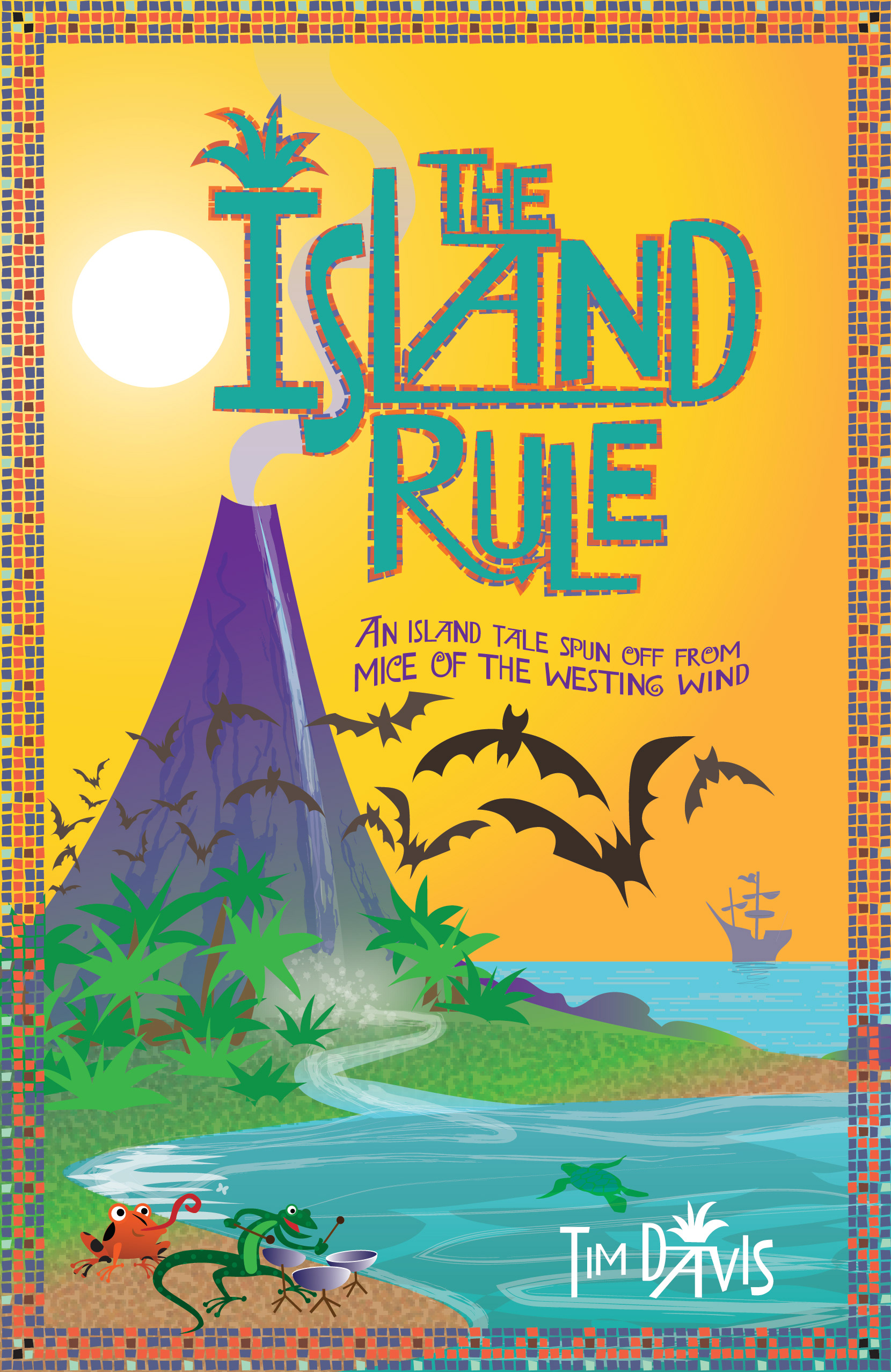
NEW! The Island Rule
Here’s how a school visit with me will work
Bring me to your school for a guest Author-Illustrator Visit.
1. I’ll help students interact with large-screen Hidden Pictures. Soon they’ll start seeing the world in a new way.
2. I’ll teach students how to make their own Hidden Pictures. Before long, they’ll find themselves developing a new kind of creativity.
3. I’ll show students the underlying message in my children’s book The Island Rule. Soon they’ll be recognizing the value of collaborating across cultures.
4. I’ll teach students how to develop their own story characters. Soon they’ll have their own story written and illustrated.
And especially,
5. I’ll tell students my own personal story. So they’ll be inspired to see new possibilities for themselves.
So what's it like? Here is a sample Author-Illustrator visit in kindergarten.
A sample three-day Author-Illustrator visit in kindergarten
Day 1
Introduction: We’ll look at Highlights Hidden Pictures
We’ll start with an introduction of Highlights magazine, which delivers over 2 million copies every month to kids around the world.
As the most prolific Hidden Picture illustrator for Highlights, with over 500 in publication, I’ll tell the students,
“When I was a kid, I enjoyed doing the Hidden Pictures in the doctor’s offices. Now I get to work for them. Think about what you enjoy doing now. If you work hard, maybe when you’re grown, you’ll get to do it too!”
Your students will use their powers of observation to study details.
When students understand that something is hidden in the picture, they study the story that the picture tells in order to find the hidden objects.
What’s going on in this picture? Who are the two groups of animals?
What should be in that picture? What doesn’t belong there? Do you see anything in a weird place?
As we proceed, finding, for example the spoon between the rabbit’s ears, students’ eyes light up with understanding and their powers of observation take off.
Ideally, every student has an opportunity to participate fully by coming to the front of the room and pointing to a hidden object on the large screen.
A curriculum objective this meets is : Students will analyze data in logical ways.
Your students will analyze the story being told in the picture.
For example, they might typically ask, “Why is the mouse inside looking out the window instead of down there on the sidewalk with the others? Why doesn’t the frog have a shirt with a number on it?”
You’ll hear them fill in their own answers to these questions. (“Maybe the mouse is sick and his mom told him to stay in bed. Maybe the frog wasn’t supposed to be in the race, but sneaked in anyway.”)
A curriculum objective this meets is: Students will practice creative problem solving.
Day 2
Your students will compare and contrast books that hide things in different ways
I’ll walk your students through four ways objects are “hidden” in popular books, each one hiding objects in a different way.
• I Spy books the reader finds a few small things in a photo of hundreds of small things.
• Where’s Waldo books the reader finds one person in a sea of people.
• Magic Eye books the reader focuses differently to see the secret picture.
• Highlights Hidden Pictures the reader finds objects that are disguised as other things.
A curriculum objective this meets is : Students will learn how to compare and contrast similar items.
As her schedule permits, Taylor Phillips of Conestee Nature Park, leads our discussion of animal camouflage
Your students will connect Hidden Pictures with camouflage in nature
We’ll observe and analyze the various ways animals hide themselves in nature using camouflage:
1. Color the same as their background—The snowshoe hare is brown in the summer and white in the winter.
2. Markings—Zebras have stripes that from a distance make them look like one big mass. A fawn has spots that make it blend in with the dappled sunlight in the forest.
3. Disguise—The katydid looks like a leaf. The walking stick looks like a stick. The owl butterfly has wings that look like an owl’s eyes.
These creatures need a lot going on in their “picture” to keep us from noticing them.
How is the camouflage in nature similar to the way we hide things in Hidden Pictures?
Placing a penny in the middle of the floor, I ask, “Is it easy to see that penny? Why is it?” Then I ask the teacher to hide the penny in plain sight somewhere else in the room.
Just the way animals are camouflaged in nature, Hidden Pictures have to have a lot going on in them in order for the objects to be well hidden. For example, in the picture below, objects are hidden in these ways:
Through the “nearly twin” trick. In the picture below, the squirrel’s chest fur looks like a Christmas tree, and the squirrel’s tail looks like a crown.
Through the “negative space” trick. In the picture below, the hidden aardvark and the bird are both examples of objects hidden “where there shouldn’t be anything.”
Through the “combine two objects” trick. In the picture below, part of the bush is combined with part of the squirrel’s tail to make the hidden chicken.
Two curriculum objectives this meets are : Students will relate concepts learned in art to other subjects such as social studies and science.
Students will describe what an image represents.
Day 3
“These are some of the Hidden Pictures I’ve created. Now, do you think kids can create Hidden Pictures?”
Usually all it takes is one brave soul shouting “Yes!” to bring a chorus of hopeful responses from the whole group.
Your students will express their creativity in their own artwork
Your students will draw a scene as a picture that tells a story, before hiding anything in it. Then they’ll explain their story to a partner.
A curriculum objective this meets is : Students will create art that tells a story.
Your students will use their imaginations to “see differently”
They’ll look for “nearly twin,” “negative space,” or “combine two objects” possibilities as they plan where to hide their objects.
Then, using tracing paper overlays, they indicate where their hidden objects should be.
They then incorporate their hidden objects into their Hidden Picture.
Students finish by displaying their very own Hidden Picture to the class.
A curriculum objective this meets is : Students will create and evaluate artwork based on criteria from art experiences and from class discussions.
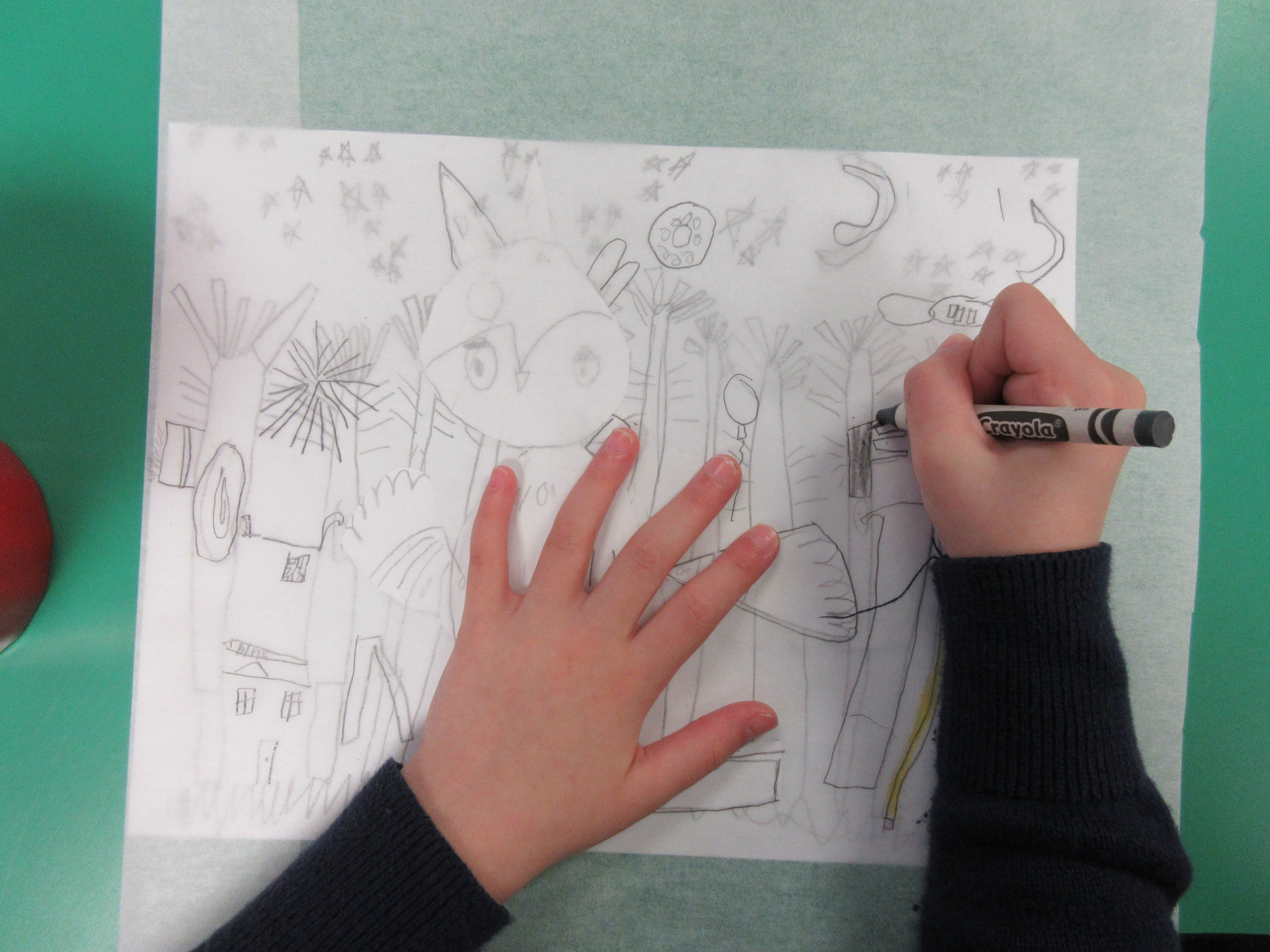
A student adds hidden objects to the picture she has drawn
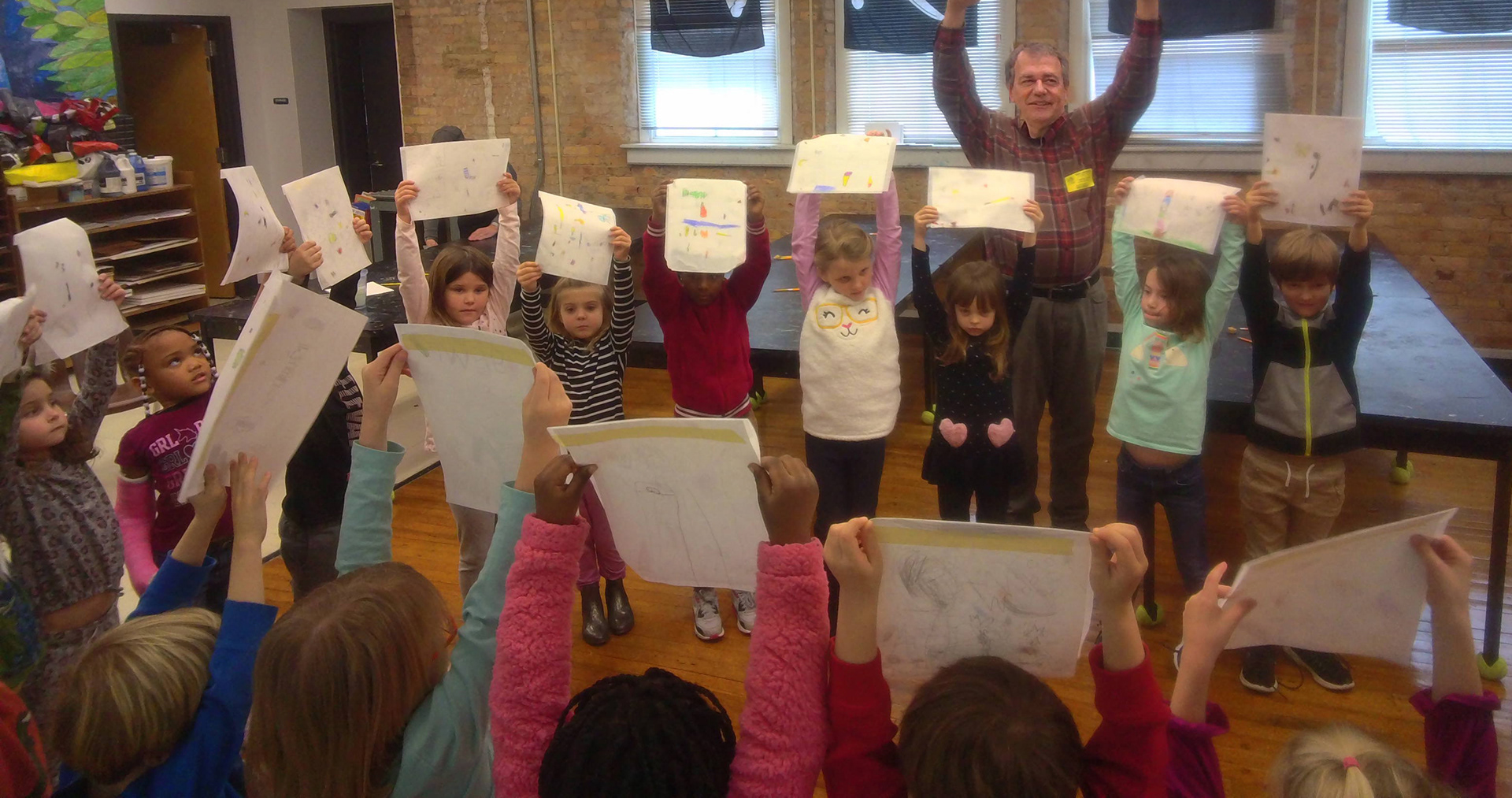
Student Art Gallery!
With my School Visit, you can look forward to . . .
Interactive learning that’s fun and engaging.
Students stretched to think in new creative ways.
Students experiencing a greater appreciation for reading, writing, and creative thinking.
Core curriculum objectives fulfilled.
For multi-day workshops, final products that students can display.
But scheduling an Author-Illustrator for your school might feel like a hassle
Even though Author and Illustrator Visits can be a positive experience in every way, studies show that only about 25% of schools host them. Schools from the poorest backgrounds host authors and illustrators least often of all.
Why is this? For most schools, it’s one of these:
• Because you don’t know where the funds would come from.
• Because it sounds like too much work to get organized.
• Because having a guest come to school seems like an interruption to your school’s curriculum plans.
But what if you could have a hassle-free School Visit experience, with an Author-Illustrator who would even do some of your work for you?
You can fund the visit through grants
Many grant programs want to help schools pay for visiting speakers, especially to advance the arts in lower-income areas.
For schools within a 2-hour drive of Greenville, SC, the cost is
• $650 for a full day (up to 4 presentations)
• $450 for each additional full day
• $300 for a single presentation
For schools outside this region, the cost is
• $850 for a full day (up to 5 presentations)
• $750 per day for each additional full day
• $500 for an additional half day (2 presentations)
(Travel expenses will also need to be reimbursed.)
Here are some of the grants typically used to fund my visits:
Arts Education Program Grants from the South Carolina Arts Commission. Simply create an account here and click “Apply.”
US Department of Education Grants for Title 1 Schools.
The behind-the-scenes process will go smoothly
If you want large assemblies, multi-day classroom workshops, or artist-in-residence programs, according to your choice . . .
1. I’ll communicate with you in a timely way. No waiting around to hear back when you have deadlines to meet!
2. You won’t have to contort your school schedule; instead, I’ll work within your schedule constraints.
3. You won’t have to try to figure out how to squeeze my visit around your curriculum guidelines. You and I will discuss and agree on the curriculum objectives you’d like to be met during my visit. Then I’ll design lessons specifically for you, around your curriculum objectives.
4. You can sit back and enjoy the Author-Illustrator Visit without worry!
Your school schedule is tight, but your Author-Illustrator Visit can help you cover required curriculum
The Common Core curriculum is placing ever-increasing demands for teachers to teach so many things.
But good news! As a SmartARTS integration instructor, my school visit lesson plans are integrated with Core Curriculum goals.
Inspiring your students to achieve to their ability, and helping them expand their creativity are both part of what will happen during my visit. But it’s more than that.
You’ll also get help fulfilling Academic Focus Standards, Visual Arts Standards, and even Science Standards. My lessons will fit with your curriculum objectives.
Any other questions?
“How are your presentations structured?”
My visits are structured around your students and your schedule.
Because all the students want to participate in my presentation, groups of 30 or fewer is ideal. But we can arrange for larger groups of up to 150 if necessary.
You can have up to 4 presentations a day. This can include a large assembly and/or several classroom visits, as you choose.
You can also arrange for multi-day workshops tailor-made for your school, as well as multi-week artist-in-residence programs.
“Where can we see more about your artwork and books?”
You can browse this website under “Illustrations” and “Books” to see more of my artwork and my books for children.
“Will you bring books to sell?”
Yes, my books will be available to autograph, for students who’d like to purchase them.
“What can we do to get students excited about your visit?”
You can receive a copy of one of my books ahead of time that you can read to your students if you’d like. You can also request some of my Hidden Pictures by email, for you to introduce to your students before the visit.
You might want to have your students make simple “Welcome” signs to post on the bulletin board or in the classroom.
Here's what other teachers and students have said about my visits

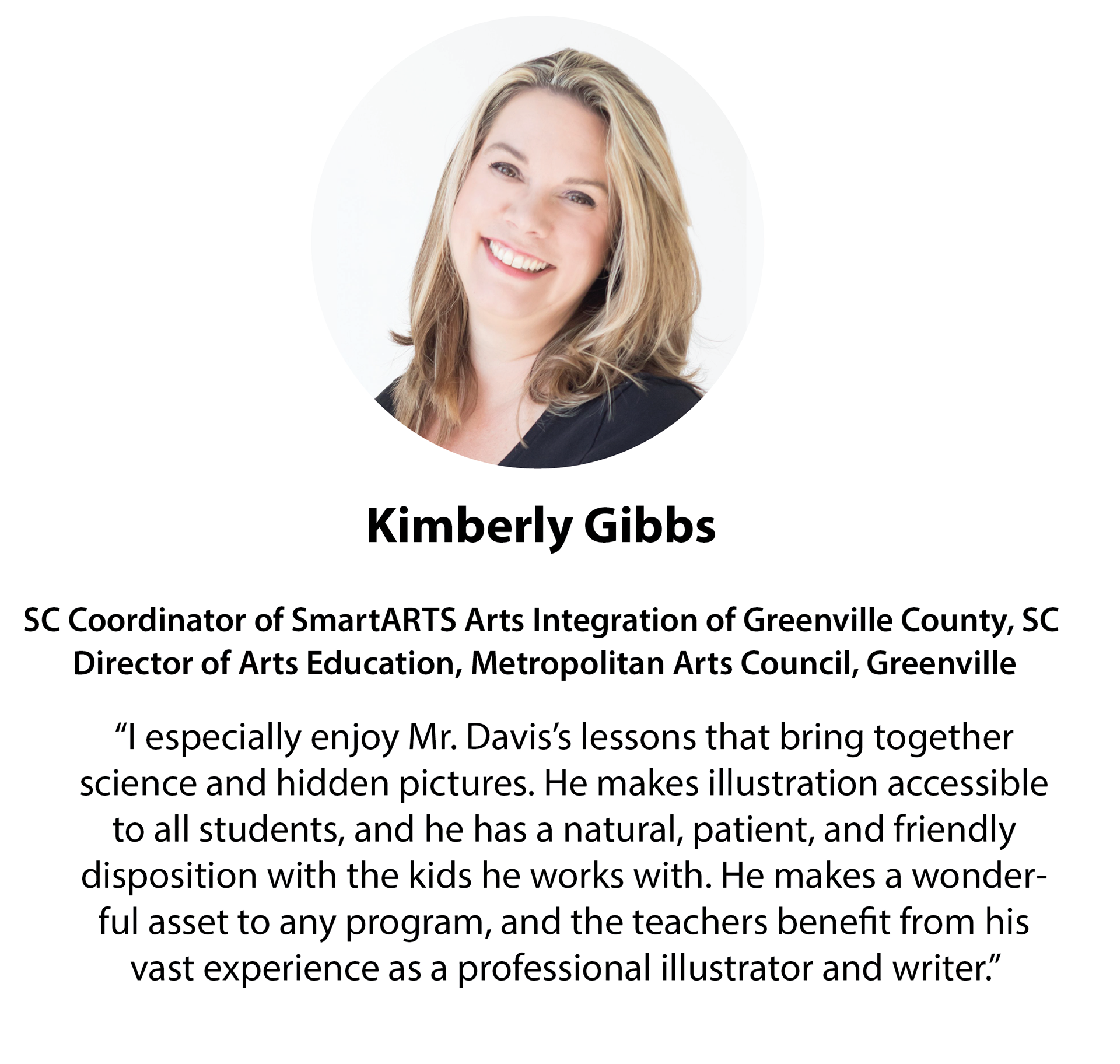
Media specialists, as well as the staff of Highlights magazine, talk about Tim's Hidden Pictures and classroom presentations
Secure your Author-Illustrator Visit now
I’m scheduling only 3 to 4 school visits per month for the 2020-2021 school year, so slots are limited. (I also have a few slots available in the spring 2020 schedule.)
You can email me at tim@timdaviscreations.com to let me know when you’d like to schedule your visit.Contact Tim to set up a school visit
Your students will remember this visit - for life.
No matter what your students speak as their primary language or what culture they represent, they’ll be able to enjoy and learn from my presentations.
They’ll be encouraged to read more, write more, and think creatively.
These visits aren’t something your students will just forget about. They can actually influence your students for life.
Don't take my word for it -- here's what some of my past students said about my stories and presentations more than 20 years ago:
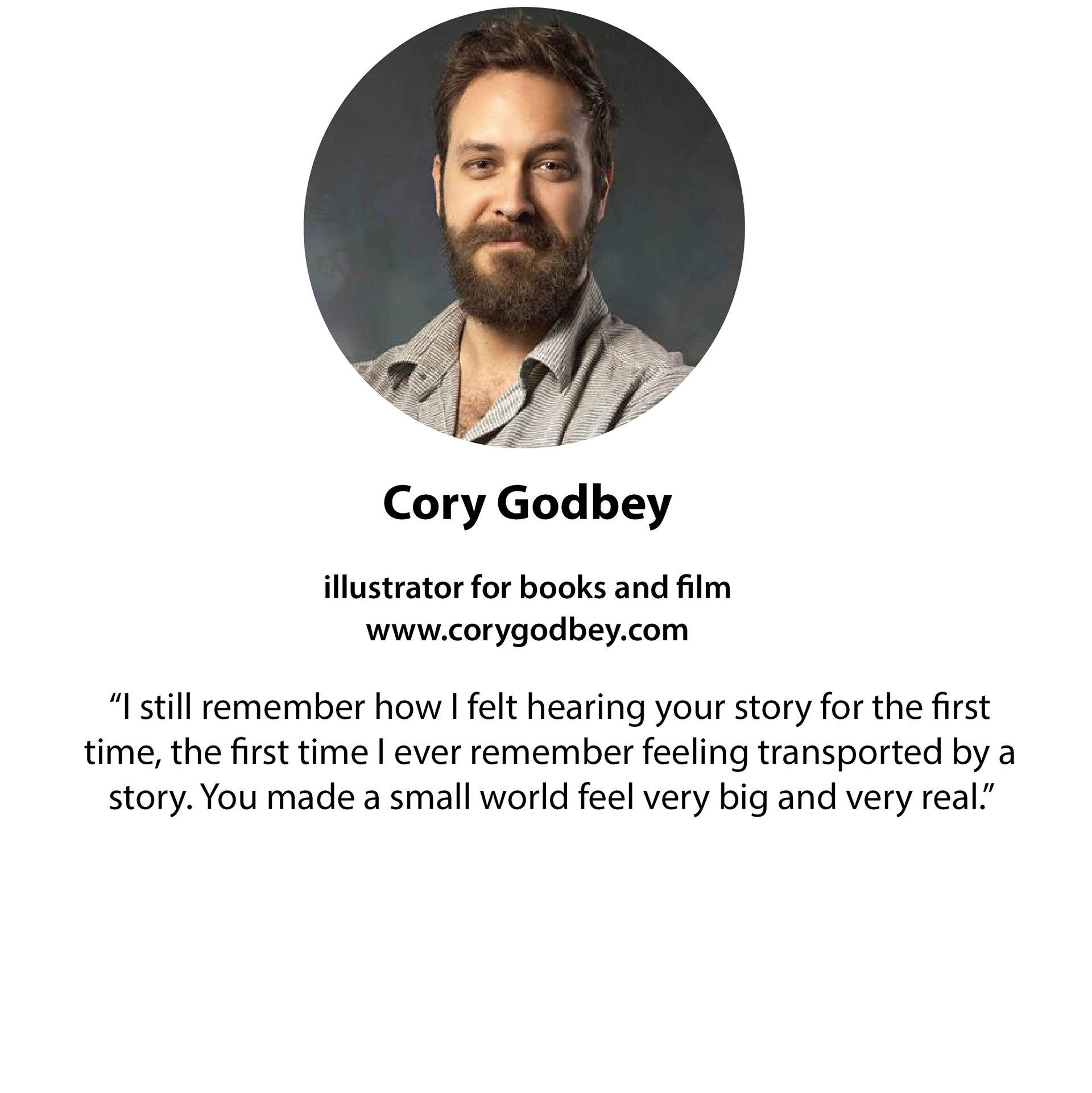
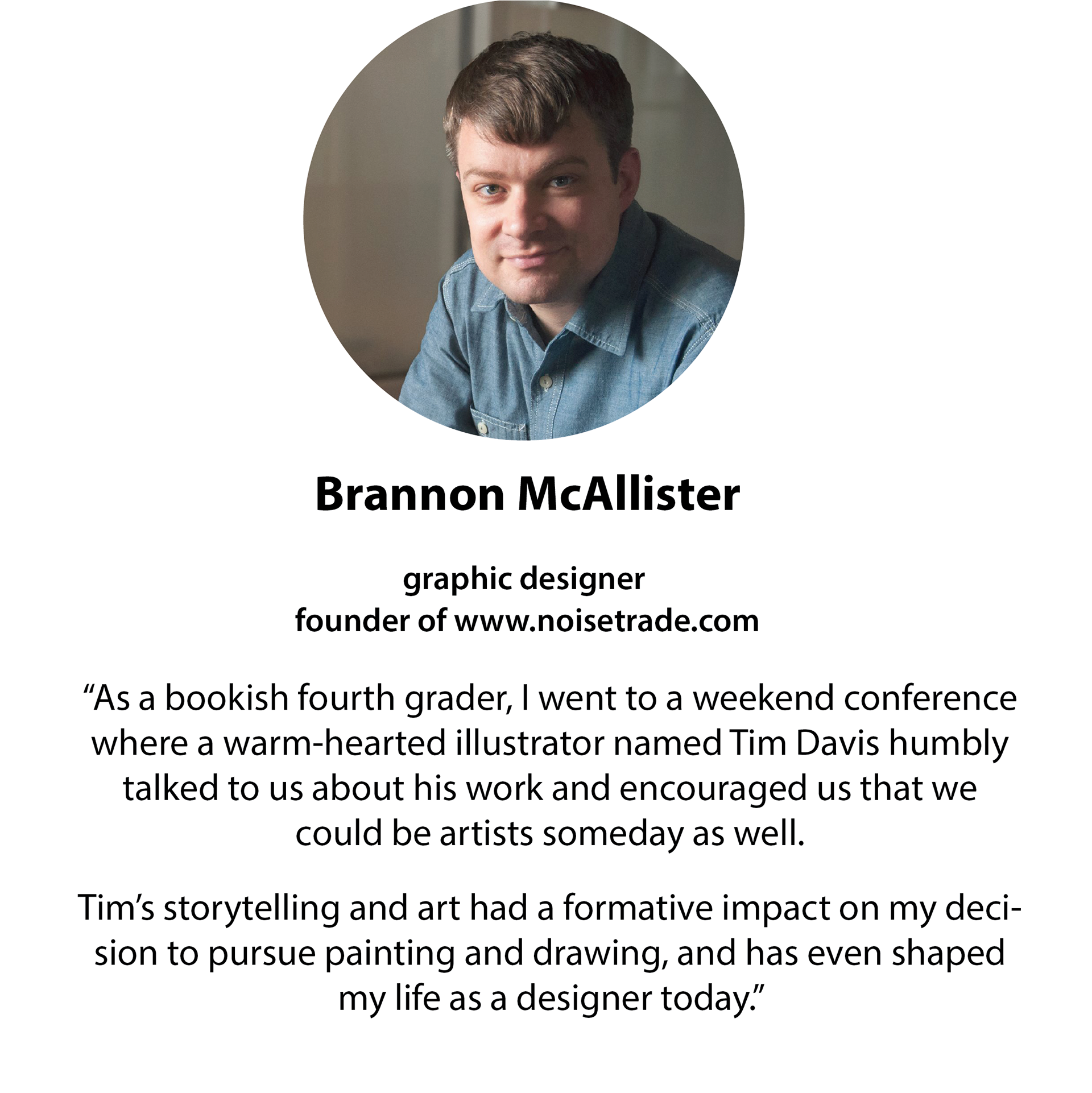
Contact me at tim@timdaviscreations.com to let me know when you'd like to schedule your visit, and let's inspire your students to become better writers, readers, and creative thinkers--for life.
See also my Facebook business page.